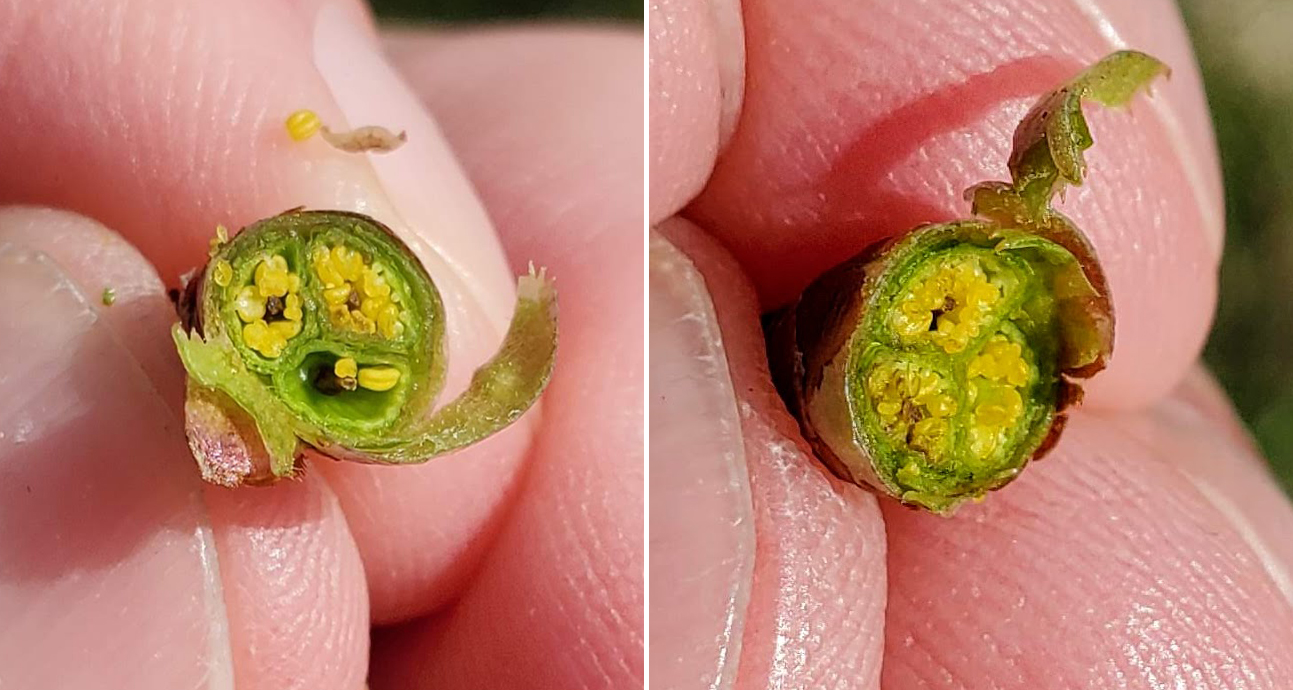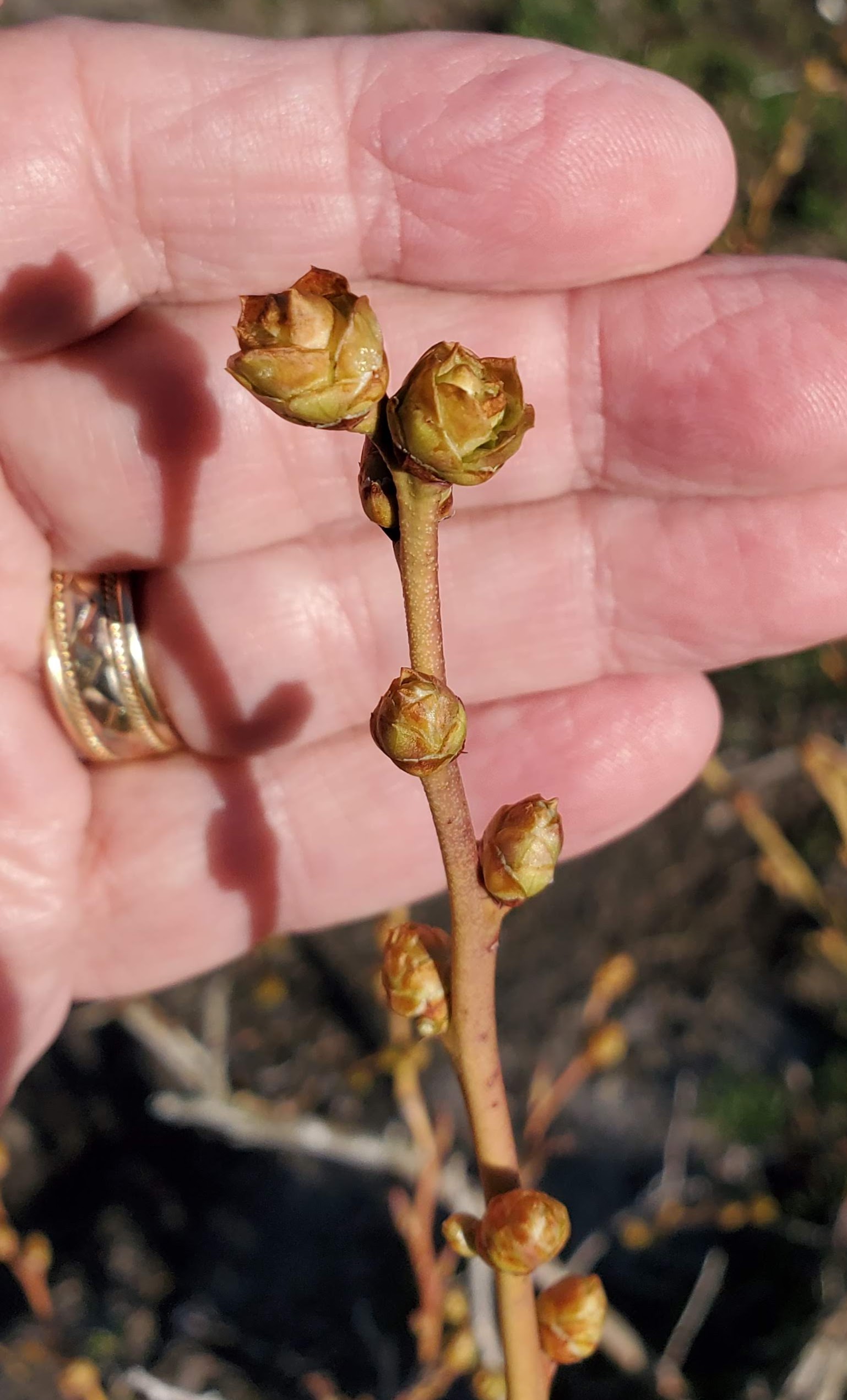Southwest Michigan fruit update – April 21, 2020
A cold, windy week with several hard radiation freezes killed open flowers on blooming apricots and plums. Damage to most tree fruit crops was spotty, depending on the crop and location.

Weather
The first full week of April was warm with highs in the 60s and 70s. Tree fruit moved quickly and early blooming crops began to bloom. Cold, windy conditions arrived with a cold front Monday, April 13. This air mass dropped high temperatures into the 30s and 40s for most of the week. Scattered snow showers and windy conditions were common. Winds died overnight and then increased in the morning. There were hard freezes on Tuesday, Wednesday and Thursday. The coldest lows were Thursday, April 16, with lows from 19 to 25 degrees Fahrenheit at different sites across the region. These temperatures are cold enough to kill open blossoms and cause damage to expanding and opening buds. Due to still conditions during this event, damage was more severe in low areas.
This cold week ended with 4 inches of snow on Friday, April 17. Saturday and Sunday were warmer. It was so cold we only picked up 13 growing degree days (GDD) base 42 and 3 GDD base 50. This heat must have come over the weekend. This was an unusually cold week for mid-April. Due to this cold spell, we are behind our long-term average for plant development.
The forecast for the upcoming week is similar to last week, cold and windy, but warmer than last week and low temperatures should not be as low. This looks like a very stable pattern for the next few weeks.
|
Southwest Michigan GDD summary from March 1 – April 20, 2020 | |||
|---|---|---|---|
|
Station |
GDD 42 F |
GDD 45 F |
GDD 50 F |
|
Benton Harbor (SWMRC) |
167 |
117 |
56 |
|
Lawton (Lawton) |
170 |
118 |
57 |
|
Fennville (TNRC) |
131 |
86 |
35 |
|
Average for the SW region |
166 |
116 |
56 |
|
Average last week |
153 |
107 |
53 |
Frost/freeze information
Freeze damage depends the developmental stage of the bud or flower. We had a three-day spell of hard freezes. Temperatures got down to 32 to 26 F on Tuesday, 29 to 27 F on Wednesday and 19 to 25 F on Thursday. The last one really hurt. Most of the fruit growing areas had lows between 22 to 24 F. Blooming fruit crops were hurt but we are finding live buds and flowers, especially in better fruit sites. We will know more after we have looked at the buds and fruit in many orchards and sites over the next few weeks.
Conditions varied a lot between different sits as to when the wind died and when the coldest temperatures occurred. Apples and peaches do not appear to be seriously hurt except in some areas. Blueberries and grapes far enough along to be hurt. See reference tables of the critical temperatures and the damage to different fruit. This table is also available as a PDF.
We do not anticipate lows this week as low as last week and little if any additional damage until the fruits develop more and get closer to bloom.
Tree fruit
Now is a good time to set up mating disruption for moth species before oriental fruit moth begin flying and mating. Codling moth and redbanded leafroller flight will begin in a few weeks
Apricots are blooming. The normal bloom date for apricots in southwest Michigan is about April 18. Apricots were hurt by last week’s freezes but there are still viable blossoms in good sites in Berrien County. Brown rot management is important when warm temperatures and moisture occur together during bloom. It has not been warm enough for this disease and it seems unlikely in the next few weeks.
Peach and nectarine buds are at calyx red and first pink is visible in early blooming varieties at the Southwest Michigan Research and Extension Center. Fruit bud density is high this year due to the low crop in 2019. Damage from the freezes was light in the good sites, especially on hills with good air drainage. Low levels of copper from early spring to early shuck split are useful in suppressing bacterial spot populations. When using copper, be sure to monitor for phytotoxicity. The average bloom date for peaches in central Berrien County is about April 27.
Sweet cherries are at tight cluster to first bloom. Damage by the frost was significant but was much less in good sites. Montmorency tart cherry buds are swollen at green tip and frost damage seems to be widespread but still needs to be fully evaluated.

Japanese plum bloom continues. Open flowers were killed by the freezes but new flowers are opening. There are significant differences in bloom timing between varieties. Japanese plums have a dense bloom with lots of lowers all over the tree. We need to wait for pollination and early fruit development to see the crop. European plum buds are swollen at side white and green tip. These buds should be able to withstand 20 F. European plums bloom about April 29.
Prune out black knot and dispose of the knots by burning or removing from the orchard. Sanitation is very important in managing this disease.
Apple buds are at half-inch green to tight cluster. Damage is generally light but there is a lot of variation from no damage to loss of some king bloom or severe damage. Maintain spray to control apple scab. Scab ascospores are being caught during rains in Berrien County. We have had multiple wetting periods in April but very few actual scab infection periods. We are still early in the scab season, only 20% of the spores have matured and about 5% discharged. Apples normally bloom the first week in May in Southwest Michigan.
Pear buds have burst and are moving to tight cluster. At this stage, temperatures would need to fall to 24 F to cause injury. Pears bloom at the end of April. Pear scab is the primary disease concern now.
Small fruit
Grapes are at early bud swell. We do not expect any damage to grapes from last week’s freezes. There is still time to apply dormant sprays for early season disease control.
Blueberry flower buds are opening. There was a little freeze damage to the most advanced buds in cold sites. Mummy berry mushrooms (apothecia) are out and growers should be applying controls (see “Mummy berry has returned and new products are available for control”). Blueberries normally bloom the second week in May.

Strawberries have greened up and new leaves are emerging from the crown. The flower trusses are still deep inside the plant and can withstand very cold temperatures. Overwintering mulches should be removed and raked between the rows. Growers are looking at early season herbicides to control overwintering weeds. If the flower trusses are below ground, there is little danger of freeze damage to flowers below ground.
Bramble leaves are beginning to unfold. Reduced rates of lime sulfur for anthracnose can still be applied. If the leaves have begun to unfold the rates need to be reduced to prevent injury.
MDARD RUP certification extended
Many growers recertify their restricted use pesticide (RUP) certification by taking an exam proctored by Michigan Department of Agriculture and Rural Development (MDARD). In-person group exams have been canceled. MDARD will certify private agricultural applicators (e.g., farmers applying on their own fields) via an oral exam administered by authorized MDARD representative. The exam consists of multiple choice and/or true and false questions based on content from the National Pesticide Applicator Certification Core Manual. Questions are read by the MDARD representative, and applicants respond orally and must obtain at least a 70% score to pass. This opportunity can only be offered for the private applicator Core exam. To schedule an oral interview, contact Lisa Graves at 517-284-5653 or GravesL@michigan.gov.
In response to MDARD’s oral exam announcement, Michigan State University Extension has created an online review for the private applicators to take prior to the test. The webinar is 4 hours and 18 minutes long and follows the core manual chapters. To purchase the Michigan Pesticide Applicator Core Manual, visit the National Pesticide Safety Education Center website.
Upcoming meetings
Our grower meetings are moving online via Zoom. You will need to register for these meetings. Do not expect to be able to join these meetings just before they start. These meetings will be closed and many will be password protected to prevent their disruption by others.
For information on Zoom and how to join and participate in meetings, the following articles are very helpful: Instructions for fruit growers on downloading Zoom for online webinars and How to join and participate in the spring tree fruit Zoom webinars.
- The Spring 2020 Tree Fruit Webinar Series continues this week with short virtual meetings for tree fruit growers during the noon hour. Growers must register to attend these virtual meetings. These webinars are free and one pesticide applicator credit is available for each meeting.
- Our regular southwest Monday Fruit IPM Updates are available online. Our next meeting is Monday, April 27, at 5:30 p.m. You need to register to receive the login and password for these meetings. The webinars are free and one pesticide applicator credit is available for each meeting. Our April 13 meeting had 54 attendees.
- The 2020 Grape Kickoff meeting will be Thursday, April 23, 1 to 4 p.m. Growers need to register before midnight on April 22.
- A pre-bloom blueberry meeting is planned for May 12.
Related articles
- Instructions for fruit growers on downloading Zoom for online webinars
- How to join and participate in the spring tree fruit Zoom webinars
- Freeze damage depends on tree fruit stage of development
- Critical Spring Temperatures for Tree Fruit Bud Stages
- Critical Spring Temperatures for Tree Fruit Bud Stages PDF
- 2013 bloom dates for southwest Michigan tree fruit crops
- Using Enviro-weather’s regional overnight temperature report during cold events
- Early insect control with horticultural oils
- Copper formulations for fruit crops
- Use fungicides for apple scab protection prior to anticipated early infection periods
- SDHI fungicides for apple scab management
- There is still time for dormant sprays in grapes
- Scouting and management of mummy berry in blueberries
- Mummy berry has returned, and new products are available for control



 Print
Print Email
Email
